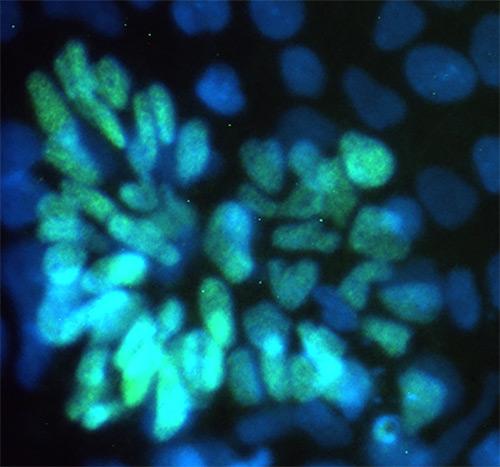Embryonic Stem Cells and Induced Pluripotent Stem Cells Are Functionally Equivalent


ESCs were cultured to become skin cells, then reverted to iPSCs and turned into neural cells (pictured) among other cell types. Credit: Jiho Choi, HSCI.
Researchers from the Harvard Stem Cell Institute (HSCI) have found evidence that embryonic stem cells (ESCs) and induced pluripotent stem cells (iPSCs) are functionally equivalent. The scientists compared genetically identical cells of both kinds and found their gene expression was almost equal. The results of the study have been published in the journal Nature Biotechnology.
ESCs are pluripotent stem cells derived from a pre-implantation embryo at the blastocyst stage, when it consists of only between 50 and 150 cells. ESCs can differentiate into any cell type and are able to proliferate extensively thanks to their high telomerase activity. This plasticity created high expectations about their use in regenerative medicine, for transplantation, tissue engineering or as in vitro models for drug tests before human trials. For almost a decade, ESCs were the only source of pluripotent cells, but in 2007 adult somatic cells were engineered into a state were they could also become any cell type. Expression of the Oct4, Sox2, and Klf4 genes, delivered to the adult cell usually via retrovirus, brings them to an undifferentiated, pluripotent state. These iPSCs, originated from skin or blood cells, have the advantage of being patient specific, eliminating histocompatibility problems in potential cell transplantation treatments. Moreover, iPSCs derived from individuals with a genetic disease are useful models for in vitro studies.
Since the emergence of iPSCs, a debate about their equivalence with ESCs ensued, and experiments were conducted that reinforced either point of view. Specifically, some researchers doubt that the artificial stem cells regulate their gene expression like natural stem cells, and thus behave like them. The main problem to prove this is the different genetic makeup of the cells compared: if they are genetically different, the differences in behaviour between EScs and iPSCs could be attributed to the genetic background and not the iPSCs reprogramming process.
Differentiating a stem cell to de-differentiate it afterwards
To answer the question properly, the ideal experiment should compare genetically equivalent cells. The HSCI team did that: they first differentiated ESCs into skin cells, then they reprogrammed the skin cells into iPSCs. Thus, they could compare ESCs and iPSCs that were genetically identical. They specifically checked the transcription and methylation profiles of both cell lines and concluded that ESCs and iPSCs do not show significant transcriptomic and epigenetic differences, and can be considered functionally and molecularly equivalent. The team found 50 genes with transcriptional difference but at such low level that could be considered transcriptional noise and very probably do not have any biological significance. The researchers also tested both cell lines potential to differentiate into several cell types and found them to be comparable.
Source: HSCI
